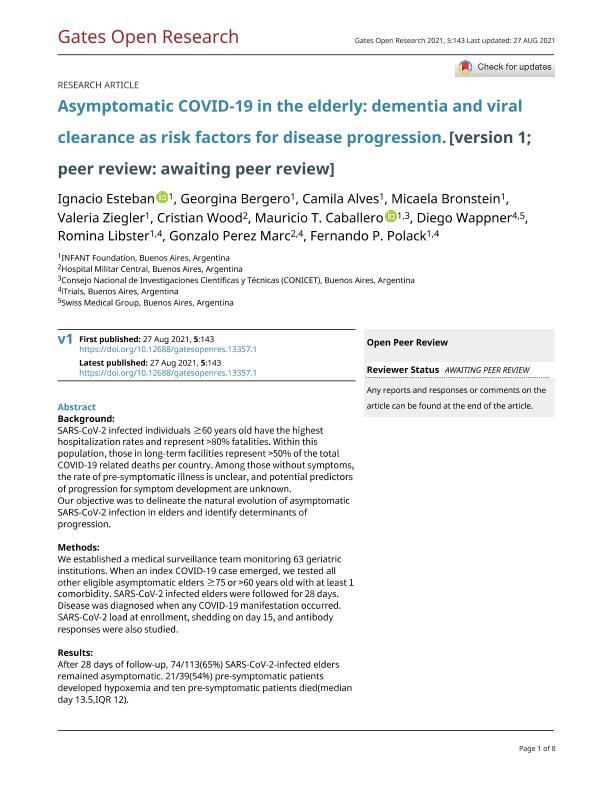Mostrar el registro sencillo del ítem
dc.contributor.author
Esteban, Ignacio
dc.contributor.author
Bergero, Georgina
dc.contributor.author
Alves, Camila
dc.contributor.author
Bronstein, Micaela
dc.contributor.author
Ziegler, Valeria
dc.contributor.author
Wood, Cristian
dc.contributor.author
Caballero, Mauricio Tomás

dc.contributor.author
Wappner, Diego
dc.contributor.author
Libster, Romina Paula

dc.contributor.author
Perez Marc, Gonzalo
dc.contributor.author
Polack, Fernando Pedro

dc.date.available
2022-02-02T12:01:02Z
dc.date.issued
2021-08
dc.identifier.citation
Esteban, Ignacio; Bergero, Georgina; Alves, Camila; Bronstein, Micaela; Ziegler, Valeria; et al.; Asymptomatic COVID-19 in the elderly: dementia and viral clearance as risk factors for disease progression; Bill & Melinda Gates Foundation; Gates Open Research; 5; 8-2021; 1-8
dc.identifier.issn
2572-4754
dc.identifier.uri
http://hdl.handle.net/11336/151159
dc.description.abstract
Background:SARS-CoV-2 infected individuals ≥60 years old have the highest hospitalization rates and represent >80% fatalities. Within this population, those in long-term facilities represent >50% of the total COVID-19 related deaths per country. Among those without symptoms, the rate of pre-symptomatic illness is unclear, and potential predictors of progression for symptom development are unknown.Our objective was to delineate the natural evolution of asymptomatic SARS-CoV-2 infection in elders and identify determinants of progression.Methods:We established a medical surveillance team monitoring 63 geriatric institutions. When an index COVID-19 case emerged, we tested all other eligible asymptomatic elders ≥75 or >60 years old with at least 1 comorbidity. SARS-CoV-2 infected elders were followed for 28 days. Disease was diagnosed when any COVID-19 manifestation occurred. SARS-CoV-2 load at enrollment, shedding on day 15, and antibody responses were also studied.Results:After 28 days of follow-up, 74/113(65%) SARS-CoV-2-infected elders remained asymptomatic. 21/39(54%) pre-symptomatic patients developed hypoxemia and ten pre-symptomatic patients died(median day 13.5,IQR 12).Dementia was the only clinical risk factor associated with disease(OR 2.41(95%CI=1.08, 5.39). In a multivariable logistic regression model, dementia remained as a risk factor for COVID-19 severe disease. Furthermore, dementia status showed a statistically significant different trend when assessing the cumulative probability of developing COVID-19 symptoms(log-rank p=0.027).On day 15, SARS-CoV-2 was detectable in 30% of the asymptomatic group while in 61% of the pre-symptomatic(p=0.012).No differences were observed among groups in RT-PCR mean cycle threshold at enrollment(p=0.391) and in the rates of antibody seropositivity(IgM and IgG against SARS-CoV-2 nucleocapsid protein).Conclusions:In summary, 2/3 of our cohort of SARS-CoV-2 infected elders from vulnerable communities in Argentina remained asymptomatic after 28 days of follow-up with high mortality among those developing symptoms. Dementia and persistent SARS-CoV-2 shedding were associated with progression from asymptomatic to symptomatic infection.
dc.format
application/pdf
dc.language.iso
eng
dc.publisher
Bill & Melinda Gates Foundation
dc.rights
info:eu-repo/semantics/openAccess
dc.rights.uri
https://creativecommons.org/licenses/by-nc-sa/2.5/ar/
dc.subject
SARS COV2
dc.subject
COVID-19
dc.subject
DEMENTIA
dc.subject.classification
Epidemiología

dc.subject.classification
Ciencias de la Salud

dc.subject.classification
CIENCIAS MÉDICAS Y DE LA SALUD

dc.title
Asymptomatic COVID-19 in the elderly: dementia and viral clearance as risk factors for disease progression
dc.type
info:eu-repo/semantics/article
dc.type
info:ar-repo/semantics/artículo
dc.type
info:eu-repo/semantics/publishedVersion
dc.date.updated
2022-02-01T17:41:13Z
dc.journal.volume
5
dc.journal.pagination
1-8
dc.journal.pais
Estados Unidos

dc.description.fil
Fil: Esteban, Ignacio. Fundación para la Investigación en Infectología Infantil; Argentina
dc.description.fil
Fil: Bergero, Georgina. Fundación para la Investigación en Infectología Infantil; Argentina
dc.description.fil
Fil: Alves, Camila. Fundación para la Investigación en Infectología Infantil; Argentina
dc.description.fil
Fil: Bronstein, Micaela. Fundación para la Investigación en Infectología Infantil; Argentina
dc.description.fil
Fil: Ziegler, Valeria. Fundación para la Investigación en Infectología Infantil; Argentina
dc.description.fil
Fil: Wood, Cristian. Ministerio de Defensa. Ejército Argentino. Hospital Militar Central Cirujano Mayor "Dr. Cosme Argerich"; Argentina
dc.description.fil
Fil: Caballero, Mauricio Tomás. Consejo Nacional de Investigaciones Científicas y Técnicas; Argentina. Fundación para la Investigación en Infectología Infantil; Argentina
dc.description.fil
Fil: Wappner, Diego. No especifíca;
dc.description.fil
Fil: Libster, Romina Paula. Fundación para la Investigación en Infectología Infantil; Argentina. Consejo Nacional de Investigaciones Científicas y Técnicas; Argentina
dc.description.fil
Fil: Perez Marc, Gonzalo. Ministerio de Defensa. Ejército Argentino. Hospital Militar Central Cirujano Mayor "Dr. Cosme Argerich"; Argentina
dc.description.fil
Fil: Polack, Fernando Pedro. Fundación para la Investigación en Infectología Infantil; Argentina
dc.journal.title
Gates Open Research
dc.relation.alternativeid
info:eu-repo/semantics/altIdentifier/url/https://gatesopenresearch.org/articles/5-143/v1
dc.relation.alternativeid
info:eu-repo/semantics/altIdentifier/doi/http://dx.doi.org/10.12688/gatesopenres.13357.1
Archivos asociados
